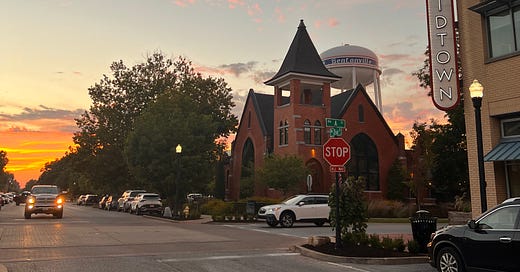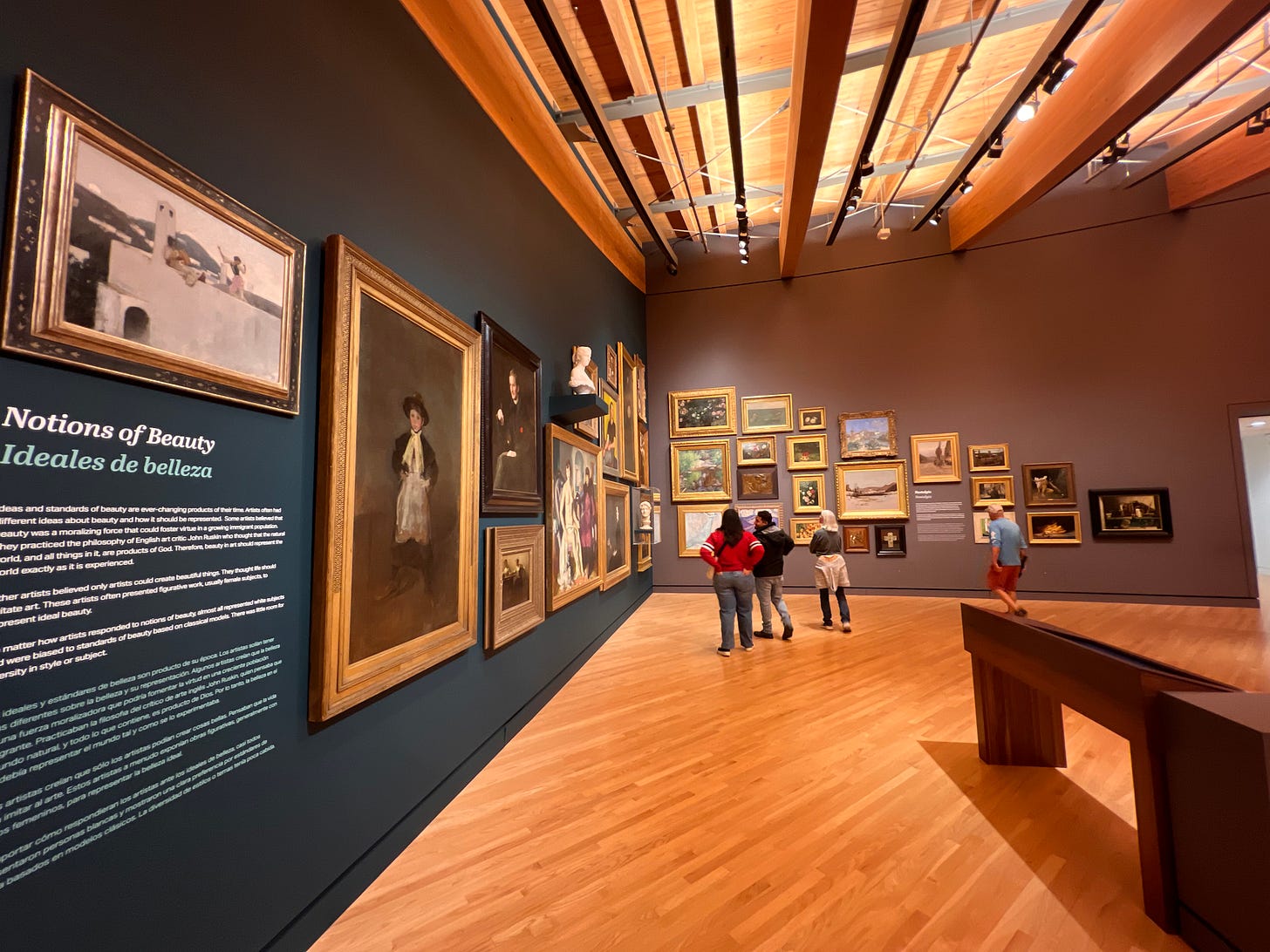Hello friends,
You may have started to think by now that I had taken a wrong turn somewhere on the way to Arkansas and ended up in the depths of the Ozarks never to be heard from again. Not to worry - I made it home to Detroit and got a little waylaid in writing this final installment of the Mega-Midwest series.
My original plan was to visit eight cities, but I was a very full sponge by the end of city number six, so I made the 13 hour drive home from Bentonville, AR on Friday. I am glad to be home, but even more glad that I decided to do this. It was a real effort to keep two and a half weeks in the calendar light enough for me to enjoy this trip and take the space I needed to see and learn, even though it was blocked off months ago. Shout out to my assistant and right hand superwoman, Mari Moughan, for making it all happen.
So much of middle America is beautiful, resilient, and worthy of time and attention. I set out on this trip to find undervalued and underappreciated people and projects making life better for people living in cities across the midwest. From my new friend Emma the regenerative farmer, to Tiffany in Tulsa who is making the trades more accessible to women, Justin the roaster making coffee out of the Duluth Folk School, and Aaron the trail builder who is making mountain biking trails in communities across the US, there are wonderful people across the midwest quietly working to make life better for their neighbors.
A Pleasant Surprise
I’ve avoided assigning superlatives to the places I’ve been, but I’ll break precedent and say that I was most pleasantly surprised by Bentonville. I enjoyed my evening strolls and morning coffee shop walks here better than anywhere else. If you were to imagine a crossover of the Truman Show, Gilmore Girls’ Stars Hollow, and Disney’s Main Street USA, you’d get pretty close to picturing a normal day in downtown Bentonville. The streets were incredibly clean, walkable, and full of great restaurants and retail. I laughed out loud when I walked past Bentonville Dive, the quintessential local dive bar that looks like it was built 10 minutes ago and has a totally artificial scum factor. The dive bar sits across from The Preacher’s Son, an upscale New American restaurant built in an old church. Down the street is a yoga studio, Onyx Coffee, a used bookstore, and more restaurants than I could name. All perfectly curated.
I remember visiting the Bloomberg headquarters in London in 2019 and my host describing the design of the building as “the brainchild of a billionaire who thinks he’s an architect and an architect who thinks he’s a billionaire”. I’d say the same about Bentonville, but swap the architect for an urban planner. Listen - I fully endorse these billionaires being urban planners in more places than Bentonville because it was truly, truly pleasant. Do I want to turn a blind eye to the fact that this little walkable urban paradise was built with the wealth accumulated by turning other people’s towns into suburban wastelands? Yes I do. Will I? Of course not. I’ll come back to that in a future post on the correlation between net worth and demand for urban walkability. Spoiler: it’s high.
The Bentonville Brand
If you’re thinking to yourself “man, Bentonville sounds so familiar… why do I know this town?”, Bentonville is the birthplace of Walmart and the hometown of its founder, Sam Walton. You’ve probably seen Bentonville printed on the side of a Walmart delivery truck. The Walton Family has kept its roots in Northwest Arkansas and invested millions of dollars into developing the city of Bentonville. Northwest Arkansas is also home to the headquarters of Tyson Foods and J.B. Hunt, both industry giants. Most American towns the size of Bentonville could only dream of having a company so large headquartered there.
The City of Bentonville has obviously benefited tremendously from the Walmart empire and the philanthropic investments of the Walton Family. The Walmart supply chain alone has spurred on the growth of many downstream businesses, boosting the local economy. Walmart has also attracted talent from all over the country, making Bentonville an outlier in terms of diversity and educational attainment. When you attracted a diverse population of highly educated talent, a town also builds amenities to keep them around.
Here’s what’s maybe most interesting to me about Bentonville:
From an outsider’s perspective, there is a clear brand and “vibe”. There’s this great line in the song Head Full of Doubt, Road Full of Promise by the Avett Brothers that kept coming to mind. It goes, “decide what to be and go be it”. Bentonville decided it was going to be a world class mountain biking and arts destination and is doing it. Let’s break this down a little further:
Legend says that Steuart and Tom Walton, avid mountain bikers, took an unforgettable mountain biking trip to Copper Harbor, Michigan and wanted to recreate that experience in their own backyards. $74M later, Bentonville is home to top tier mountain biking trails that attract more than 90,000 visitors per year. They host mountain bikers from all over the world, along with events that draw athletes and spectators. They book up local hotels, eat at restaurants, and shop in local stores, generating tax revenue that creates a strong and sustainable city. Side note: I might be one of the only people to see both Copper Harbor and Bentonville in the same roadtrip, a fascinating comparison and case study in how far tourism gets a small town.
We now understand the mountain biking, but what makes Bentonville an arts town? Crystal Bridges, Bentonville’s Museum of American Art founded by Alice Walton kickstarted the local arts focus from what I understand. Alice Walton is the only daughter of Sam and Helen Walton and has been a lifelong arts collector, purchasing her first piece at 10 years old with money she earned working at her father’s store.
Crystal Bridges was recommended to me by literally everyone who had been to Bentonville and knew I was going and boy were they spot on. I loved it! Rather than focusing on the collection (which is amazing and unique), I want to talk more about what Crystal Bridges is contributing to Bentonville as an institution. While no museum specific data is available, here’s what the NWA Gazette says about the economic impact of Crystal Bridges and the Momentary, Bentonville’s modern art museum:
The museum industry in Arkansas supports an estimated $385 million in economic activity, 7,250 jobs and $89.4 million in taxes annually, according to the report. About $258 million in wages and other income are earned by people working in the state's museum sector each year.
More than 5.6 million people have visited Crystal Bridges since it opened in 2011, with the vast majority visiting from outside Northwest Arkansas.
I actually ended up walking through the museum twice - once for the art and once for the architecture. It was so hard to enjoy both at the same time and IMO, they were equally wonderful. I loved that the architecture was entirely unique and striking, but also humble. I find most museums to be stuffy, but the design of Crystal Bridges made it so no one in the museum felt out of the place, even in rain boots and hoodies. I imagine that inviting but beautiful architecture that reflects the natural landscape creates a real sense of belonging for the residents of Northwest Arkansas.
Here’s my last takeaway: it’s really interesting to see how two philanthropists in two different cities spent $500M.
Tulsa: The Gathering Place funded by George Kaiser for $465M
Bentonville: Crystal Bridges funded by Alice Walton for $403M
Both investments centered on one thing - one legacy project that was deeply rooted in place. The glass of Crystal Bridges literally reflects its natural surroundings while the Gathering Place is carefully tucked away within the natural landscape of Tulsa’s riverfront. Neither project addresses the systemic inequities present in the local economies, nor do they explore or aim to solve complex social issues. Instead, they are monuments to place that will provide an enduring economic impact and service to the community. I don’t think either approach is right or wrong - it would be limiting to apply a binary to them. Just an interesting thing to ponder.
Thank you all for following along in this journey. Writing about each place was a huge challenge and really stretched me, but I am so glad I did it. I’ll have something to look back on years from now and, hopefully, it was fun and rewarding for you too. My aspiration for this newsletter is to surface important things happening in urban places and inspire its readers to think differently about their relationship to their place. I’ll keep it going so long as you’ll come along for the ride!
Until next time,
Alex






